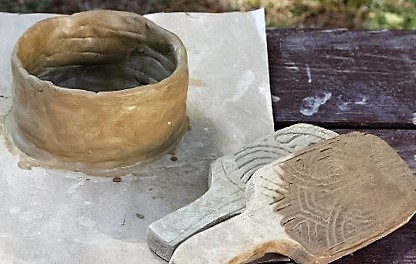Last updated: June 21, 2018
Lesson Plan
Mississippian Coiled Pottery Making

- Grade Level:
- Lower Elementary: Pre-Kindergarten through Second Grade
- Subject:
- Social Studies
- Lesson Duration:
- 30 Minutes
- Thinking Skills:
- Creating: Bring together parts (elements, compounds) of knowledge to form a whole and build relationships for NEW situations.
Essential Question
What is clay? It is earthen material that soft and can easily be formed to make bricks, title, and pottery. What is pottery? Pottery is fired clay that becomes hard and can be used as containers for cooking, eating, and storing food.
Objective
Students will understand why American Indians made pottery for their daily use. They will understand how they made the pottery by hand. The will learn the process of coiled pottery making through hands on learning activity.
Background
American Indian came to Georgia during the Ice Age around 12,000 year ago. They lived off the land and use what materials they could find to use as tools. One tool that they need on daily basis was containers to store their food. They discovered that clay in the ground could be molded into any shape they needed. Since it was the man’s job to hunt, the women learned to gather berries and nuts growing in the wild to eat along with the meat the men provided. The women used clay from the ground to make pottery (dishes and cookware). Pottery was used for eating, storage, and cooking.
The American Indians started making pottery during the Archaic Period (9000-1000 BCE). The oldest pottery known in North America was found near Savannah, Georgia. The first pottery was dated to 3500 BCE. The first pottery was only used for eating and storage because the clay was too weak to put directly into the fire for cooking. Around 1000 BCE the American Indians learned to mix sand, seashell, and fiber in with the wet clay to make it strong enough to put into the fire to cook food.
Ocmulgee National Monument had the largest archaeology dig in American history with over 3 million artifacts found. Many of those artifacts are pottery sherds (broken pieces of pottery). Almost 100 different types (designs) pottery sherds were found at the park. Pottery sherds help tell the story of the Pre-historic lifestyles of the American Indian cultures.
Some of the most uniquely decorated ancient pottery in North America was created along Swift Creek here in Macon. The Swift Creek pottery dates from 2000 BCE-805 CE. Some archaeologists believe that the Swift Creek designs represent insects, birds, snakes, flowers, circles, teardrops, and spirals. The American Indians put designs in their pottery during different time periods. Archaeologists can tell how old a piece of pottery is by its design. The designs were first made with natural materials such as sticks, corncobs, and rope. During the Woodland Period (1000 BCE-900 CE) they carved designs into a wooden paddle called “stamping paddles” and press it into the soft clay walls of the pottery before it was fired.
Preparation
Materials needed:
- Lizella Clay- Ocmulgee National Monument has it available at the park
- Plastic table cloth or paper (to protect the table tops)
- Clay wire or dental floss ( to cut the clay)
Materials
Shows how to make the coiled pottery
Lesson Hook/Preview
Things for children to think about without having pottery:
- Without dishes how would you eat stews?
- How would collect blackberries you have found in the woods to take back to the village?
- What would you store your water in?
- How would cook your food without it being in a container over the fire?
Procedure
How to make coiled pottery:
- Pinch off some clay (golf ball size) and make it into a ball
- Take your ball and make a pancake out of it. But not too thin. This will be the bottom of your pot.
- Roll another piece of clay into a coil (like a snake) then wrap it around the top of your pancake.
- Make four coils to put on top of your pancake.
- After four coils (it should look like a pot; if not add more coils) take your finger and smooth and blend the clay until it is smooth. (Do not squeeze the clay to smooth)
- While the clay is damp you can now decorate it with designs. You can use sticks, pencils, or other objects.
- Dry the pot for at least 5 days before taking it home.
- Children may paint the dried pot with craft paint if they choose. (Since the pots cannot be fired like the American Indians did; the paint will help the pot look nice for years.)
Vocabulary
- Archaeology- the scientific study of material remains (such as fossil relics, artifacts, and monuments) of past human life and activities
- Archaeologist- someone who studies material remains (such as fossil relics, artifacts, and monuments) of past human life and activities
- Artifact- a usually simple object (such as a tool or ornament) showing human workmanship or modification as distinguished from a natural object; especially : an object remaining from a particular period
- Clay- an earthy material that is plastic when moist but hard when fired, that is composed mainly of fine particles of hydrous aluminum silicates and other minerals, and that is used for brick, tile, and pottery; specifically : soil composed chiefly of this material having particles less than a specified size
